Correcting the care of tomatoes: why tomatoes don’t bloom in a greenhouse, how to properly help the bushes
It is known that if there are no flowers on tomatoes, there will be no harvest. Difficulties with pollination often affect plants grown indoors. Why tomatoes don’t bloom in a greenhouse and what to do to solve this problem, you will learn from this article.
Conditions necessary for setting tomatoes
Solanaceae are fastidious plants, the proper development of which is influenced by many factors. Vegetable growers who grow tomatoes in greenhouses often encounter the problem of ovary formation. Before you begin to look for the root of the problem, you need to determine whether the greenhouse conditions are suitable for the proper development of plants.
For tomatoes to bloom, you need the following:
- air humidity - 60%;
- air temperature +20…+25°С;
- watering once a week;
- loosening and mulching the soil.
The main causes of flowering failure
There can be many reasons why a plant does not bloom. It is important to correctly identify the source of the problem in order to eliminate it. Typically, difficulties with ovary formation occur when the plant lacks something.
The formation of flowers is influenced by many factors:
- pre-planting soil treatment;
- seed quality;
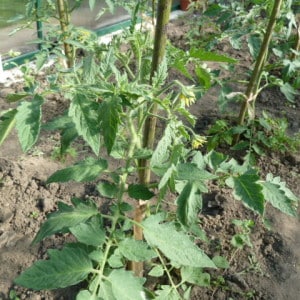
- compliance with the temperature regime - if the stems and leaves of the tomato are massive, but there are no flowers, this indicates that the plant is freezing;
- proper care;
- insects - their lack can lead to the flower not being pollinated;
- good lighting;
- development of the root system;
- weather - on rainy days insects cannot pollinate plants;
- the amount of nitrogen in the soil - if there is an excess of it, the stem is beautiful and juicy, but there are few flowers and they are sluggish and twisted;
- correct stepsoning;
- development of diseases - late blight, tobacco mosaic virus, black rot;
- pests - aphid, whitefly, spider mite;
- the amount of fertilizers in the soil - if there is an excess of them, the plants have a large fleshy green mass, while the ovary is very weak;
- proper watering - lack of moisture can be determined by the following signs: leaves curl, the top green mass dries, and the soil at the roots cracks. With high humidity, fungal diseases begin to develop.
Important. Lack of pollination is one of the main problems with growing nightshades in a greenhouse. If in open beds this process occurs naturally, then in greenhouses and hotbeds the vegetable grower needs to make additional efforts to form flower ovaries. A pollinated flower can be recognized by its petals - they are open and slightly tilted back.
Other reasons
Often flowers do not appear on tomatoes due to errors in care. Beginning gardeners often make mistakes, which can result in them being left without a harvest.
The most common mistakes are:
- Planting density - crowded bushes prevent sunlight from penetrating to the roots of the seedlings.
- Treatment with pesticides. In the fight for the harvest, they use drugs that have a bad effect on the development of plants. Plants should not be treated during the flowering period.
- Tomato variety. When choosing multi-fruit varieties, it is worth considering that the stem may not have enough resources to form all the ovaries. This problem often occurs in tomatoes with large fruits.It is also worth considering that hybrids are not suitable for collecting seeds, since do not bear fruit during subsequent cultivation.
- Incorrect location of the greenhouse. Plants may suffer from lack of heat and light.
Fighting methods
Once the source of the problem has been identified, it is important to immediately begin taking steps to eliminate it.
Using the “right” seeds
The quality of seedlings plays a big role in obtaining a bountiful harvest. It is important to purchase seeds from trusted producers. The quantity and quality of flowers can be affected by how they were stored, processed and packaged. Many gardeners prefer not to take risks and use their own seed collected from the garden beds. However, if you planted a hybrid, this makes no sense.
If you are not sure about the quality of the seeds, you can check them before planting for germination. Additional pre-planting treatment will also protect against various diseases and increase the chances of abundant flowering.
Bush formation
Stepsoning - the most common method of forming a bush, thanks to which the root system of the plant develops correctly. There are varieties of tomatoes that do not require pinching, but most require timely pinching of the crown and removal of yellowed leaves.
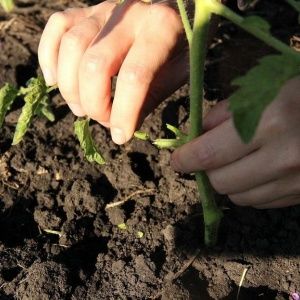 The most powerful stepson appears under the first flowering ovary. The processes located below must be removed. There are two options for carrying out the procedure: tearing it off by hand or cutting it off. It is important to do this as carefully as possible so as not to introduce an infection to the damaged plant site.
The most powerful stepson appears under the first flowering ovary. The processes located below must be removed. There are two options for carrying out the procedure: tearing it off by hand or cutting it off. It is important to do this as carefully as possible so as not to introduce an infection to the damaged plant site.
You need to pick off the shoots several times a week. The procedure is carried out in the morning of a sunny day. The cut area can be coated with brilliant green.In addition to breaking out the lateral shoots, you need to tear off the yellowed lower leaves. It is enough to remove 1-3 leaves per week.
It is also important to maintain distance when planting plants to prevent the beds from becoming crowded.
Lighting adjustments
The development of nightshades is negatively affected by both lack and excess of light, so it is important to maintain a balance. The lack of lighting can be compensated for by planting the plants in the garden bed so that there is a distance of 70 cm between them. This distance is enough for the sun's rays to freely fall on the lower leaves. You can also install additional lighting.
Carry out thinning and pinching in a timely manner. To avoid overcrowding, you need to pull out weeds, as well as nearby seedlings, once every few weeks.
Proper feeding
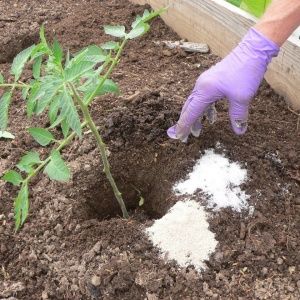 Phosphorus and potassium help tomatoes grow. If these elements are not added to the soil, this can lead to the development of diseases and, as a result, the death of seedlings.
Phosphorus and potassium help tomatoes grow. If these elements are not added to the soil, this can lead to the development of diseases and, as a result, the death of seedlings.
Tomatoes especially need phosphorus and magnesium. You can make up for their shortage with the help of store-bought fertilizers or a folk remedy - yeast. Wood ash is well suited for feeding. It can be poured under each bush or a solution for spraying can be prepared based on it.
Excess fertilizer is also dangerous, so it is important to observe the measure. This rule also applies to organic fertilizers. So, in the case of heavy fertilization with manure, the soil can become oversaturated with nitrogen. This substance gives the plant growth, but does not contribute to its flowering.
Important! Tomatoes need to be fed no more than 4 times per season.
If there is an excess of fertilizers:
- use phosphate fertilizers for root and foliar feeding;
- add sawdust to the soil;
- tear off excess leaves that interfere with the free circulation of air and the penetration of sunlight;
- regularly ventilate the greenhouse;
- Stop watering the plants while the soil recovers.
Pest and disease control
You can protect yourself from pest invasion by planting plants between the beds that repel them. These include: calendula, marigold, nasturtium, cilantro, dill, parsley and peppermint.
If there are a lot of insects, you can use tomato-safe herbal decoctions of wormwood, tansy, dandelion, celandine, burdock and lemon balm. 1 kg of herb is poured with a bucket of water and left for 2-3 days.
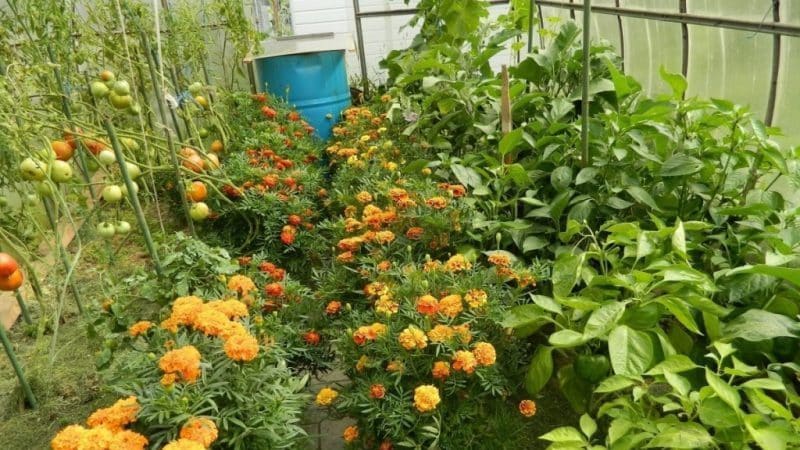
It is better to prevent nightshade diseases than to try to cure them later. Therefore, you should not neglect prevention: treat the seeds before planting, provide conditions favorable for plant growth, and also regularly disinfect garden tools and greenhouse structures.
Many diseases manifest themselves in the fact that the leaves begin to turn yellow and wither, which negatively affects the fruits. At the first signs of disease, infected plants must be removed from the beds and treated with antiseptic and fungicidal preparations.
Air temperature
It is important to maintain the temperature regime in the greenhouse. The thermometer readings should not fall below +15°C, otherwise this will lead to the fact that the flowers will not open and the pollen will not ripen. As a result, the plant may lose its ovaries and even die. At an air temperature of +30°C, pollen becomes sterile, which is why flowers can wither and fall off.
Important! Before planting seedlings, you need to assess the weather conditions. If there is a possibility of cold weather returning, then it is better to wait.
If the problem with the lack of flowers lies in the cold nights, you can use a potbelly stove or an electric heater to heat the greenhouse. You can also raise the temperature in the greenhouse in a simple way - water the plants with warm water. This method is used when the thermometer drops to 15°C outside.
During hot weather, you can reduce the air temperature by pouring cold water on the paths in the greenhouse or placing containers of water in the room. You also need to open the windows and doors in the morning and evening for ventilation. On particularly hot days, you can cover the greenhouse with reflective material or install an additional canopy.
Artificial pollination when there is a lack of insects
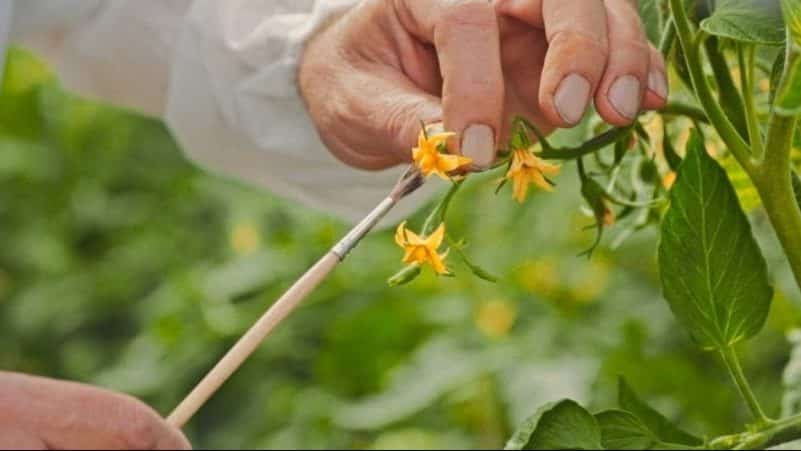
The problem of pollination in a greenhouse can be solved artificially. The grower will need to independently transfer the pollen from flower to flower using a brush. You can gently shake the plants so that the pollen falls off on its own, or use a fan. The procedure is carried out in the morning, as the pollen ripens at night.
You can also attract bees indoors. To do this, pots with honey plants are placed throughout the greenhouse. To attract other insects, you can spray the plants with a solution of boric acid.
Humidity control
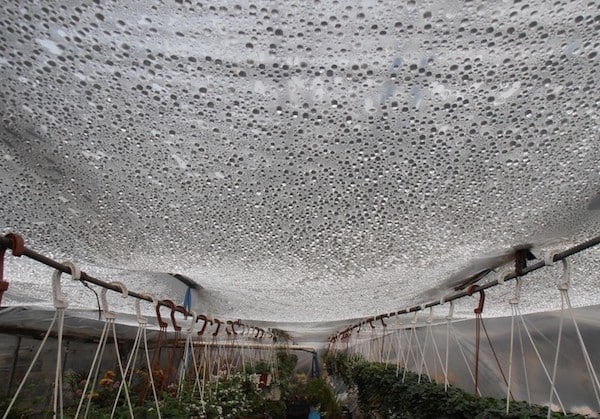
Excess or lack of moisture also affects the development and health of tomatoes. The optimal humidity levels for growing them are 40-70%.
Due to increased humidity, pollen swells and becomes heavy. It is difficult for insects to carry it, as it collects in clumps. As a result, pollination becomes impossible.
Excessive dry air is just as dangerous as high humidity. You can increase air humidity by pouring cold water on the paths in the greenhouse.The procedure should be carried out in the morning to prevent condensation from forming. You can also place a container of water in the room.
In a greenhouse, it is important to ensure a constant flow of fresh air. Usually in warm weather the room is ventilated in the morning and evening. If the air temperature stays within +20...+26°C, then the greenhouse doors can be left open all night.
Mulching the soil will also help cope with high humidity. You can spread straw or polyethylene over the beds.
Proper watering
The temperature of the water for irrigation plays a very important role. If you water with cold water, you can chill the root system. Experienced summer residents do not water tomatoes with spring water or from the tap, but use settled water, the temperature of which is more comfortable for the plants.
During the flowering phase water plants need once a week. Water is poured directly under the root, making sure that drops of moisture do not fall on the leaves.
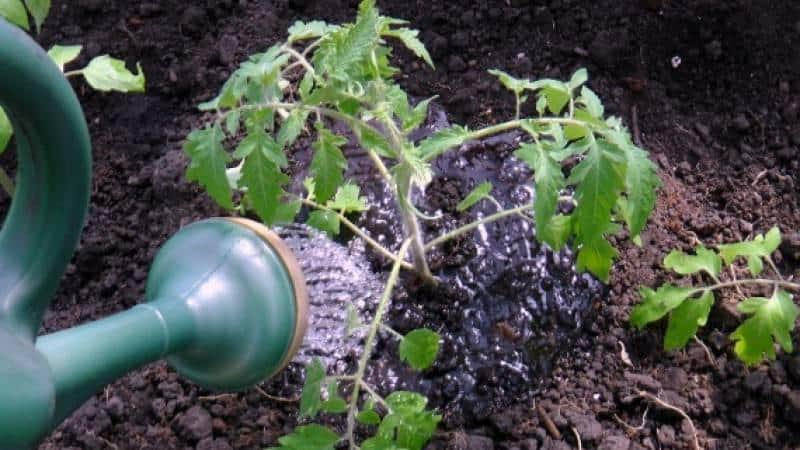
Prevention
Negligence is unacceptable in growing tomatoes - an oversight can lead to the loss of the entire crop. To protect plants from diseases and increase the number of ovaries, you can use simple methods:
- when pests appear, immediately begin combating them;
- at the first symptoms of diseases or fungal formations, begin treatment;
- observe moderation in the use of nitrogenous fertilizers, refuse to use them during the flowering period;
- Feed the plants before flowering.
Secrets of experienced gardeners
Tomato pollination problem typical for greenhouses. Often the natural process may not be possible due to the lack of wind and pollinating insects. In these cases, you can often ventilate the room so that a draft carries pollen and insects have free access to the plants. Some vegetable growers help the plants by gently shaking them so that the pollen falls off on its own.
You can help the plant bloom with the help of processing. For these purposes, you can use double superphosphate and potassium sulfate. Add 15 grams to a bucket of water. components. Manganese solution and boric acid will also help the proper formation of ovaries.
If pollination occurred artificially, you need to increase the humidity immediately after the procedure. You can water the plants or spray them with a spray bottle. After a few hours, you need to open the greenhouse for ventilation.
Some gardeners plant several varieties of tomato, differing in resistance to disease and climate. This measure is a safety net in case one of the varieties produces an empty ovary.
If measures are taken and the problem is not solved, you need to remove all barren flowers from the plant. This method will force the seedlings to devote all their resources to the formation of new ovaries.
Conclusion
Getting a rich harvest largely depends on care. And if it is sometimes impossible to change external factors, then you can learn to adapt to them. If the tomatoes in the greenhouse do not want to bloom, you need to find out the root of the problem and eliminate it.
It is important to provide favorable conditions for plant growth and immediately sound the alarm if they begin to wither for no apparent reason. Often, for pollination, a vegetable grower needs to take on the functions of insects and independently spread plant pollen. This is not difficult to do, so even novice gardeners can cope with the task.